‘For this the mechanism of capitalist production provides beforehand, by converting the working class into a class dependent on wages, a class whose ordinary wages suffice, not only for its maintenance, but for its increase. It is only necessary for capital to incorporate this additional labour-power, annually supplied by the working class in the shape of labourers of all ages, with the surplus means of production comprised in the annual produce, and the conversion of surplus-value into capital is complete.’[101]
This is the first solution which Marx gave to the problem of the accumulation of the aggregate capital. Having dwelt on this aspect of the question already in volume i of Capital, Marx returns to the problem at the end of the second volume of his main work whose concluding 21st chapter is devoted to accumulation and enlarged reproduction of the aggregate capital.
Let us examine Marx’s diagrammatic exposition of accumulation more closely. On the model of the diagram of simple reproduction with which we are already familiar, he devised a diagram for enlarged reproduction, the difference appearing most clearly if we compare the two.
Assuming that society’s annual aggregate product can be represented by an amount to the value of 9,000 (denoting millions of working hours, or, in capitalist monetary terms, any arbitrary amount of money), the aggregate product is to be distributed as follows:
Конец ознакомительного фрагмента.
Текст предоставлен ООО «ЛитРес».
Прочитайте эту книгу целиком, купив полную легальную версию на ЛитРес.
Безопасно оплатить книгу можно банковской картой Visa, MasterCard, Maestro, со счета мобильного телефона, с платежного терминала, в салоне МТС или Связной, через PayPal, WebMoney, Яндекс.Деньги, QIWI Кошелек, бонусными картами или другим удобным Вам способом.
